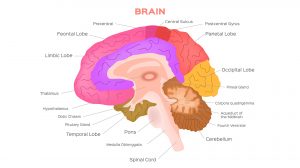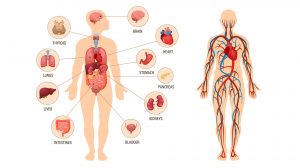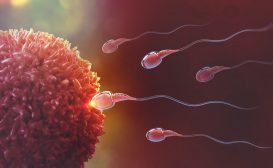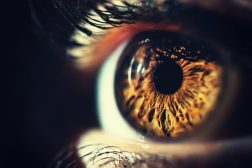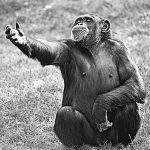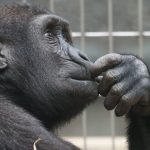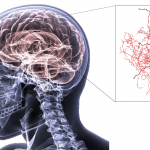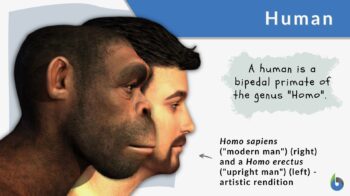
Human
n., plural: humans
[ˈ(h)ju.mən]
Definition: A bipedal primate belonging to the genus Homo, especially Homo sapiens (modern humans)
Table of Contents
Human Definition
A human is a bipedal hominin characterized by having a higher and vertical forehead compared with earlier hominins. The brain volume is about 1,400 cc. The teeth and jaw are smaller and the chin is prominent. Humans are the hominins capable of creating and using complex tools, solving problems by sense and reasoning, using symbols and language, and creating complex social structures. Over time, humans have demonstrated behavioral modernity and advancement.
Characteristics Of Humans
Humans are regarded as a member of the biological kingdom Animalia (animals). In particular, humans belong to the tribe Hominini of the family Hominidae. Hominidae, in turn, belongs to the order Primates, of class Mammalia (mammals) and then of phylum Chordata (chordates). Chordates are characterized by their possession of a notochord.
Vertebral column and Mammary Glands
Humans have notochords at one point in their lives, particularly during the embryonic stage. At the fetal stage, the notochord becomes part of the vertebral column (similar to other vertebrates). And by the time of birth, the neonate is brought forth by live birth, and then nourished with breast milk produced from the mother’s mammary glands, which is a major distinguishing characteristic of mammals.
Highly developed brain
Humans belong to the family Hominidae, particularly of the tribe Hominini (hominins). One of the common distinctive features of hominins is the possession of a highly developed brain. The brain of a human being is larger than the other hominins but not the biggest. Nevertheless, the human brain has advanced skills in abstract reasoning, articulate language, self-awareness, problem-solving, and sapience.
The human body morphology is bilaterally symmetrical. The body consists of: head, neck, torso, and four limbs. Unlike other animals, humans lack an external tail. They are sexually dimorphic. In essence, males and females exhibit different characteristics apart from differences in sexual organs. On average, adult males are taller and heavier (based on average mass) than females.
The human body is comprised of the following major body systems: integumentary system, muscular system, nervous system, reproductive system, skeletal system, digestive system, urinary system, respiratory system, cardiovascular system, circulatory system, lymphatic system, endocrine system, and immune system. Each of these systems is made up of organs that function as a whole. The organs, in turn, are made up of tissues that carry out a particular function. The tissues consist of cells engaged in certain metabolic activities. An adult human body has about 100 trillion cells.
The human body contains multifarious types of cells, e.g. neurons, white blood cells, erythrocytes, hepatocytes, adipocytes, stem cells, bone cells, myocytes, sex cells, secretory cells, etc. The cells of the human body are eukaryotic; the cell contains compartmentalized structures called organelles. The nucleus contains chromosomes that bear genes that set the distinctive traits of an individual human being.
Like all other mammals, humans are diploid eukaryotes. This means the body cell has two sets of chromosomes. A total of 46 chromosomes come from the two sets of 23 chromosomes where one set is paternal and the other is maternal. Of the 46 chromosomes, two of them make up the sex chromosomes, i.e. X chromosome and Y chromosome. According to the XY sex-determination system in humans and other mammals, a female has two X chromosomes whereas a male has one X chromosome and one Y chromosome.
Life Cycle
Humans reproduce through internal fertilization by means of sexual intercourse. At copulation, the female copulatory organ (vagina) receives the male copulatory organ (penis). The penis ejaculates semen containing sperm cells (male sex cells). The sperm cells travel through the female’s vagina, cervix, uterus, and then into the Fallopian tube whereby at ovulation an egg cell (female sex cell) is discharged from the ovary. Only one sperm cell would be able to fertilize the egg cell. The zygote that forms from fertilization divides mitotically and lodges in the uterus to develop into an embryo. The human embryo undergoes the following major embryonic stages: blastula » gastrula » neurula. The embryonic phase covers the first eight weeks of gestation. By the ninth week, the embryo develops into a fetus.
After nine months of gestation, the fetus would be fully grown and is set for birth. Unlike in other species, the birthing process in humans is painful and difficult. One of the consequences of bipedalism is a relatively narrow birth canal (pelvis). Added to this factor is the larger head size of human babies than those of other primates. Thus, the baby turns around while passing through the birth canal – a feature that is not observed in other primates. Humans are also the only species that usually need help from other humans (conspecifics) to mitigate the dangers of birthing. The newborn is less developed and more vulnerable compared with the neonates of other primates. Nourishment is primarily via breastfeeding.
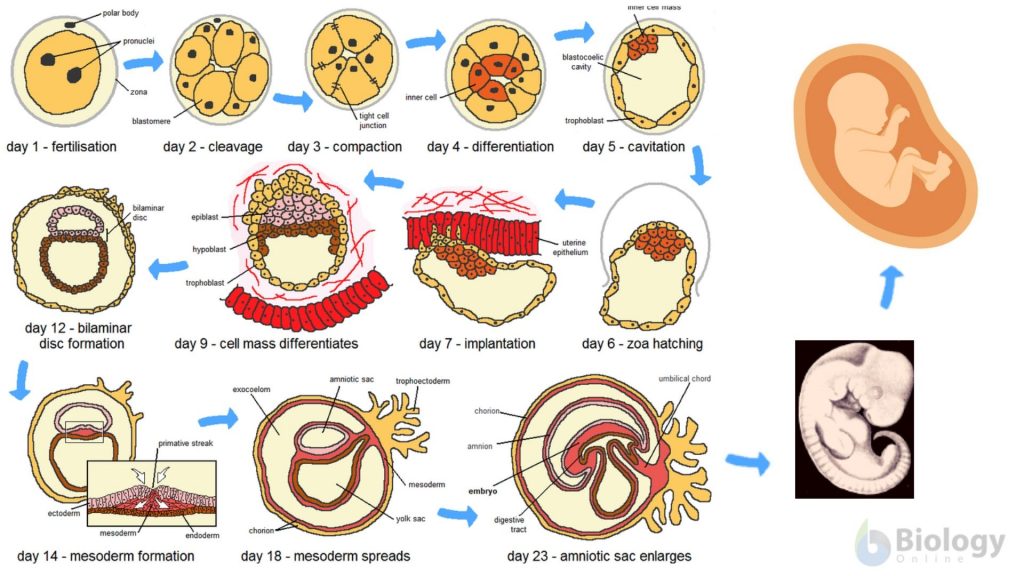
Human post-natal developmental stages are as follows: infancy » childhood » adolescence » adulthood » senility. Humans experience a growth spurt during adolescence wherein the body grows 25% in size. Sexual maturity is reached typically at 12 to 15 years of age and continues to develop at around the age of 18 in females and 21 in males.
Unlike non-human ape females that are capable of giving birth until death, human females (women) are not. Women are one of the few species that go through a menopausal stage where they are no longer fertile and capable of birthing a child. Human males (men), in contrast, could remain fertile up to old age. Men may still be able to produce sperms even at senility depending on genetics and lifestyle choices. Nevertheless, the quality and the amount of semen and sperm cells usually decline with age.
According to World Health Organization’s Global Health Observatory (GHO) data, the average life expectancy at birth of the global population in 2016 is 72.0 years.2
Human Evolution
A brief timeline of the evolution of the hominids before the emergence of Homo is shown below:
Phanerozoic eon » Cenozoic era » Neogene period » Pliocene epoch: (before Homo)
Table 1: Timeline of Hominid Evolution Before the Emergence of Homo | |
|---|---|
| Period | Highlights |
| 15 million years ago | The family Hominidae or the great ape ancestors emerged. Hominids include the great apes, such as humans, chimpanzees, gorillas, and orangutans. One of the tribes under family Hominidae is Homonini (“hominins”). The tribe includes lineages of humans (Homo habilis, Homo erectus, Homo neanderthalensis, etc.) and Australopithecus. |
| 10 to 4 million years ago | The latest common ancestor of humans and chimpanzees emerged. These ancient ancestors had larynx that theoretically was positioned in a way that it could have led to vocalized speech in humans. |
| 3.6 million years ago | One of the earliest hominins — Australopithecus afarensis – that lived between 3.9 and 2.9 million years ago left footprint fossils in Kenya. The fossil serves as a proof of earliest full-time bipedalism. |
| 3.5 to 3.2 million years ago | A Pliocene hominin fossil of Kenyanthropus platyops was retrieved in 1999. The species emerged 3.5 to 3.2 million years ago. They are surmised as the ancestor of Homo species. Based on archeological findings, the species could be the earliest stone-tool users. |
| 3 million years ago | The genus Australopithecus fossils were discovered and believed to have evolved in eastern Africa and spread throughout the continent. The genus includes the australopith species, which is believed to have later evolved into the genus Homo in Africa (e.g. Homo habilis, and eventually to modern Homo sapiens). |
A brief timeline of the evolution of humans (Homo) is shown below:
Phanerozoic eon » Cenozoic era » Quaternary period » Pleistocene epoch:
(NB: Paleolithic period refers to the early human cultural phase highlighted by the use and creation of stone tools. It occurred near the beginning of the geologic time, Pleistocene epoch.)
Table 2: Timeline of Human Evolution | |
|---|---|
| Period | Highlights |
| 2.5 to 2.0 million years ago | The genus Homo, apparently, first appeared in East Africa. They emerged from Australopithecus after splitting off from the lineage of the chimpanzees (i.e. genus Pan). In this period, Homo habilis (regarded as the first hominins to make and use sophisticated stone tools) appeared. Homo erectus emerged about 2 million years ago. Archeological findings indicate that H. erectus lived in Africa, and later spread outside, to Europe and Asia. Thus, Homo erectus might have lived together with Homo habilis in Africa for nearly half a million years. |
| 1.9 to 0.5 million years ago | Homo erectus is regarded as the first hominids to have controlled fire. This ability, which was conjectured to begin around 1.5 million years ago, was a major turning point in human evolution. It led to closer ties among them as fire served various purposes critical to living in groups. The fire was used for warmth, protection, hunting, and cooking food. It also enabled them to navigate through the dark. |
| 0.43 or 0.25 to 0.04 million years ago | Homo neanderthalensis (Neanderthals) emerged and lived in Eurasia. The species became extinct 40,000 years ago. Interbreeding with Homo sapiens might have occurred between 60,000 and 40,000 years ago. |
The earliest Homo sapiens was presumed to have emerged about 300,000 years ago. And based on estimates, vocal languages probably developed between 350,000 and 150,000 years ago. They expanded and lived in many parts of the world. They were able to come up with more sophisticated hunting techniques, clothing using animal hides, rituals (e.g. burying the dead), cave paintings, and so on. The first civilizations occurred about 12,000 years ago.
Modern humans continuously innovate and eventually contrived contemporary forms of governments, religions, technologies, medicines, education, industries, and cultures. Population growth rose exponentially. And as of 2018, the estimated human population worldwide is 7.7 billion. Homo sapiens (the anatomically modern humans) are the only extant species of the genus Homo.
Humans are still evolving. One of the proofs is observed in a tribe of nomadic divers (Bajau). Compared with other humans, they evolved to have relatively larger spleens that allow them to use oxygen more efficiently, and thus, enable them to stay underwater for a period longer than most humans can.3
Species
Below is the list of human species (genus Homo).
- H. habilis
- H. rudolfensis
- H. gautengensis
- H. erectus
- H. ergaster
- H. antecessor
- H. heidelbergensis
- H. cepranensis
- H. rhodesiensis
- H. naledi
- H. neanderthalensis
- H. floresiensis
- H. tsaichangensis
- Denisova hominin
- Red Deer Cave people
- H. s. sapiens (modern)
Research
The Human Genome Project, a global collaborative research project, is geared towards identifying and mapping all the genes of the human genome. It attempts to determine the sequences of nucleotide base pairs that make up the DNA of the estimated 20,000 human genes.
Human is a term used to refer to a primate of the genus Homo. One of the distinctive features of humans is their forehead which is vertical and relatively higher than those of the earlier hominins. They have smaller teeth and jaw and a prominent chin. Their brain volume is about 1,400 cc.
Example: Homo sapiens (commonly known as “modern humans”)
Etymology: from Latin “hūmānus”, of “homō”, meaning “man”
Scientific classification:
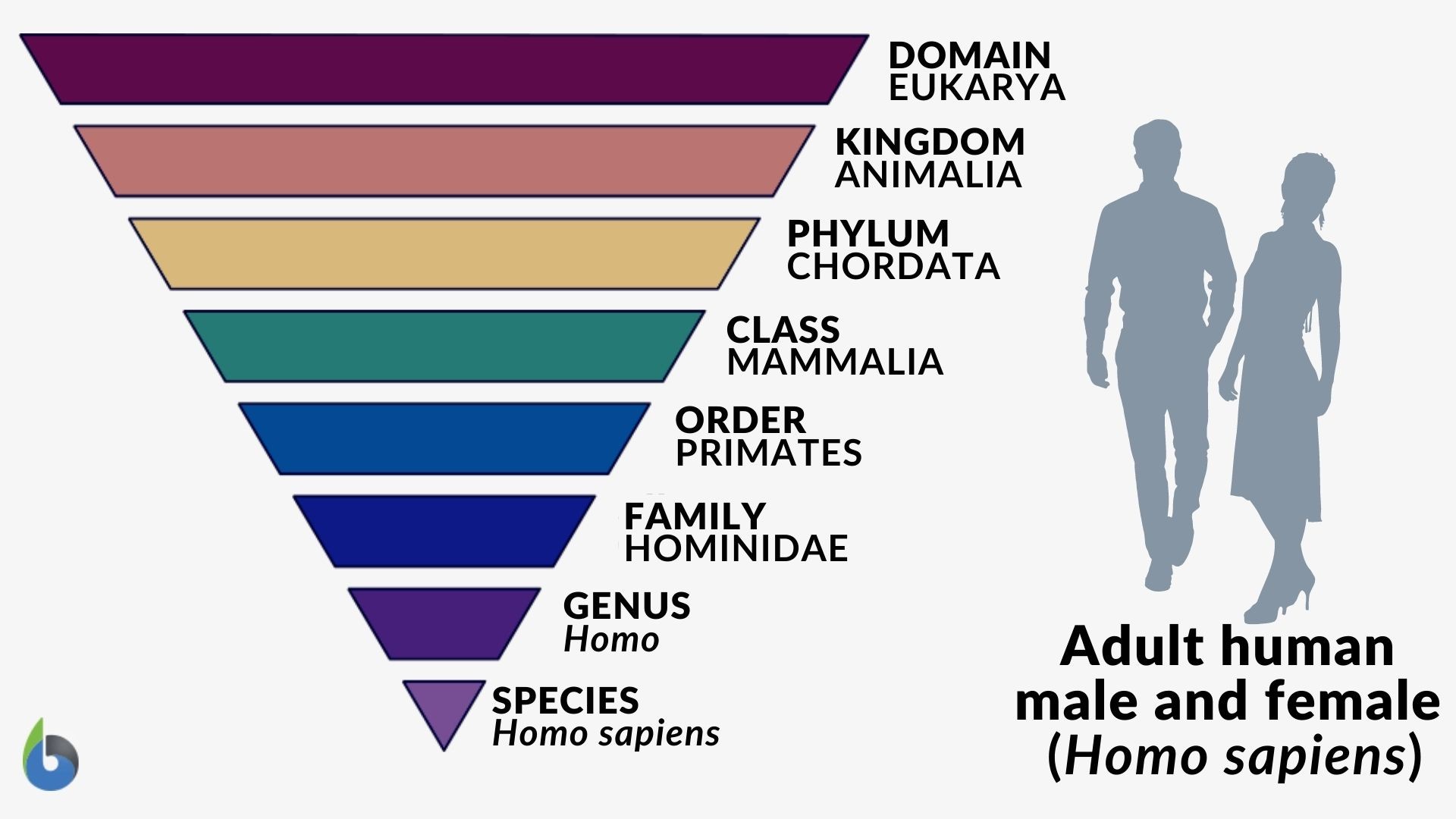
Scientific name:
- Homo sapiens
Common name:
- human being
Try to answer the quiz below to check what you have learned so far about humans.
Further reading
References
- Rangopal S. How does sweat help to maintain body temperature? LIVESTRONG.COM. Retrieved from Link
- Life expectancy. (2018). World Health Organization. Retrieved from Link
- Ilardo, M. A., Moltke, I., Korneliussen, T. S., Cheng, J., Stern, A. J., Racimo, F., Damgaard, P. D. B., Sikora, M., Seguin-Orlando, A., Rasmussen, S., et al. (2018). Physiological and genetic adaptations to diving in sea nomads. Cell, 173(3). doi:10.1016/j.cell.2018.03.054
© Biology Online. Content provided and moderated by Biology Online Editors

